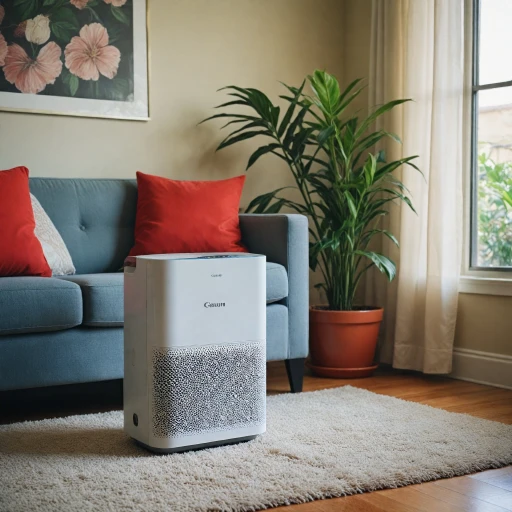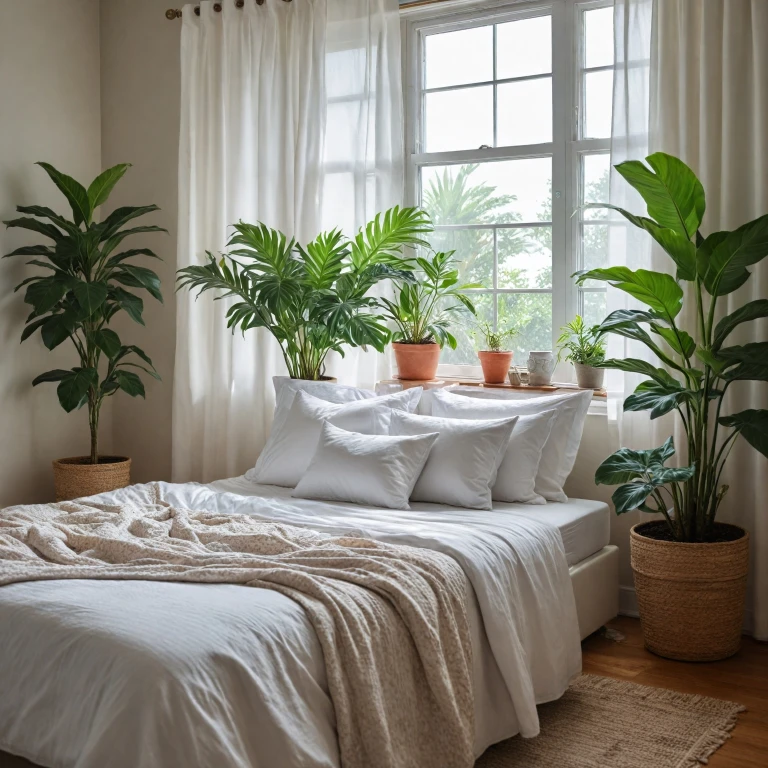Understanding Airflow Dynamics
Deciphering the Airflow Patterns
To establish optimal placement for an air purifier in your bedroom, it's essential to first grasp how air moves within the room. Airflow dynamics can significantly impact the purifier’s effectiveness in delivering clean air—especially when it comes to ensuring quality sleep.
Understanding how air currents form and flow through the bedroom can reveal where the pollutants concentrate, enabling strategic placing of your purifier. Several factors, from the unit's design to the room size, can influence these dynamics. A thorough assessment will help determine the best spot to place your unit for effective air purification. This strategic approach ensures air quality is maintained, offering better sleep and improved health benefits.
Proper placement of the purifier is about much more than just clearing airborne pollutants. It involves creating an airflow pattern where the clean air circulates through the entire room, reaching all corners. Frequent adjustments might be necessary. Over time as you evaluate the positioning, placing the air purifier in different locations can highlight where its impact diminishes or maximizes.
Interestingly, a welcoming suggestion is to run your purifier consistently, especially throughout the night when sleep quality is paramount. Determining the
optimal duration for running an air purifier can complement good placement strategies, ensuring that clean air circulates without interruption.
Avoiding Common Placement Mistakes
Avoiding Mistakes for Effective Purifier Operation
When it comes to placing an air purifier in your bedroom, avoiding certain common errors can greatly enhance its effectiveness. Proper placement is essential to ensure the air purifier can efficiently improve air quality and provide clean air while you sleep. Here are some key mistakes to avoid and tips on placing your air purifiers correctly:
- Avoid Obstructions: Ensure the air purifier is not blocked by furniture or walls. This can hinder airflow, resulting in less effective air purification. The unit should have plenty of open space around it, ideally allowing for a few feet of clearance on all sides.
- Steer Clear of Corners: Placing your purifier in a corner might seem logical, but it diminishes airflow and reduces its effectiveness to capture pollutants such as dust and allergens. Consider placing the purifier closer to a central part of the room for optimal air circulation.
- Mind the Bedside Placement: While placing a purifier close to the bed seems like a good approach to breathe clean air all night long, ensure it is not directly adjacent to the bed. This could lead to noise levels that might disrupt sleep. Aim for a spot where the purifier isn’t too close to your head but still within a reasonable proximity to cover the bed area efficiently.
- Balance the Noise Levels: Consider the noise output of the purifier. A unit that produces higher noise levels can be disturbing during sleep. Choose a model with a sleep mode or quieter operation if possible.
- Consider Room Size: Larger bedrooms might require either more than one air purifier or a unit designed for larger spaces. Ensure that your air purifier’s coverage matches your room size for the best performance.
By paying attention to these details, you can ensure better air purification performance, providing an optimal sleeping environment. Remember to regularly check and replace filters to maintain the unit's efficiency over time. For further insights on strategic placement for maximum coverage, you can read more on the
Optimal Placement for the GT3000 Air Purifier, which offers specific guidance on how to achieve the best results with your air purifiers.
Strategic Placement for Maximum Coverage
Maximizing Air Purification Efficiency
When placing air purifiers in your bedroom, strategic positioning is key to ensuring optimal air quality. To maximize the efficiency of your air purifier, it's important to consider several factors that impact its performance.
Consider the
size of your room and the air purifier's capacity. If the device is too small, it won't effectively clean the air, whereas an oversized unit might lead to unnecessary noise levels and higher energy consumption.
Next, ensure unobstructed airflow around the device. Placing the unit too close to walls, furniture, or curtains can hinder its ability to filter pollutants. Ideally, the purifier should be placed at least 3 feet away from these barriers to allow for efficient air circulation.
Keep the purifier close to the source of pollutants, especially if you have pets or experience allergies. Near your bed is an ideal spot as this will enhance the purity of the air you breathe while you sleep, promoting a restful environment.
Finally, remember that regular adjustments might be necessary. Over time, shifting the air purifier within the room can ensure even distribution of clean air and maintenance of air quality. Regular price checks for filters and unit price can also guide timely upgrades and replacements.
Strategic placement, aided by an understanding of airflow dynamics, will not only maintain clean air but also improve the overall efficacy of your air purification efforts.
Considering Bedroom Layout and Furniture
Consider Your Bedroom Furniture Arrangement
When placing an air purifier in a bedroom, the layout and the furniture arrangement play significant roles in ensuring optimal air quality. Every bedroom is unique, and recognizing the distinctive features of your room can make a difference in the purifier's performance.
- Bedroom Size: The room size can impact how an air purifier functions. Larger rooms may require more powerful units to ensure complete coverage. Consider measuring your space to confirm if your current unit is suitable for your room size.
- Furniture Obstructions: Avoid placing air purifiers behind furniture or curtains, as these can block airflow. Your goal is to ensure clean air circulates generously throughout the room, avoiding stagnation in corners or areas blocked by furnishings.
- Height Placement: The placement height can affect how well your purifier works. While it might seem convenient to place it on the floor, elevating the unit on a sturdy table can sometimes help disperse air more efficiently. However, ensure that whatever surface you choose, it does not obstruct intake or outflow vents.
- Distance from Pollutants: Consider placing the purifier close to known sources of pollutants, such as windows facing a high-traffic street or close to pet sleeping areas to capture and process pollutants swiftly.
Maintaining good air quality in your bedroom requires careful consideration of where you place your air purifier. Regularly assessing the effectiveness of its placement in conjunction with any changing room layouts or furniture arrangements will ensure your bedroom remains a sanctuary for restful sleep.
Special Considerations for Allergies and Pets
Taking Care of Allergies and Pets
When it comes to enhancing air quality in your bedroom, having allergies or pets demands extra attention in terms of air purifier placement. The presence of allergens and pet dander can significantly impact the quality of your sleep and overall well-being. Therefore, it's crucial to strategically place your air purifier to ensure optimal air purification.
- Addressing Allergens: If you're prone to allergies, position the purifier close to areas where allergens, such as dust mites and pollen, are likely to accumulate. This includes near the head of your bed to ensure clean air is directly available as you sleep.
- The Challenge of Pet Dander: Pet owners should place the air purifier where their pets spend most of their time. This is often close to pet beds or favorite lounging spots. This ensures that the air purifier effectively captures pet hair and dander, keeping these common indoor air pollutants from causing issues.
- Ensuring Adequate Airflow: It’s important to maintain clear airflow to and from the device. Avoid placing your air purifier in locations where airflow might be obstructed, such as too close to furniture or walls, as this can reduce the effectiveness of the filters and hinder optimal air cleaning.
Regular assessment of your purifier's effectiveness and adjusting its position accordingly can make a difference in maintaining the clean air in your bedroom. Remember, the best placement is where the unit can operate without obstruction and contaminants are most prevalent.
Evaluating and Adjusting Placement Over Time
Assessing the Effectiveness of Your Air Purifier Setup
Regular evaluations are essential to ensure that your air purifier is functioning optimally within your bedroom. Even the best unit will require some adjustments over time to maintain clean air quality. Here's how you can assess and tweak its placement:
- Monitor Air Quality: Equip yourself with a reliable air quality monitor. It can help you track pollutants in the room and identify if your current placement strategy is effective.
- Check for Dust and Particles: Regularly inspect your purifier's filters. A buildup of dust and particles may indicate reduced air filtration efficiency, necessitating a change in the purifier's position.
- Evaluate Room Size and Layout: As your bedroom's furniture or layout evolves (perhaps a new bed or additional furniture), reassess the air purifier's placement to ensure airflow and coverage remain optimal.
- Listen to Noise Levels: If your air purifier is too noisy, it might be worth repositioning it farther from your bed. This can help maintain a peaceful sleep environment without compromising air quality.
- Analyze Airflow Patterns: Reassess the airflow dynamics within the room, as discussed previously. Changes in the room's setup or the addition of an HVAC system can alter how air circulates, affecting how pollutants are captured.
- Consider Seasonal Changes: With each season, the quality and type of indoor air pollutants can vary. Reevaluate the purifier placement during seasonal transitions to account for these differences. For instance, pollen may be more prominent in spring, requiring a focus on different areas.
Aligning these strategies with the context of your daily routine and needs will ensure that your bedroom's air purification system operates at its peak, delivering the clean air necessary for optimal health and restful sleep.

